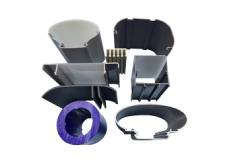Therefore, when encountering severe shrinkage problems of thick and large pieces, it is necessary to adopt some unconventional injection molding techniques, otherwise it will be difficult to solve the problem.
First of all, on the premise of ensuring that the injection molding profile is not deformed, the method of shortening the cooling time as much as possible is adopted to allow the injection molded parts to be ejected from the mold early at high temperatures. At this time, the temperature of the outer layer of the injection molded part is still very high, and the skin is not too hardened, so the temperature difference between the inside and the outside is relatively small, which is conducive to the overall shrinkage, thereby reducing the concentrated shrinkage inside the injection molded part.
Because the overall shrinkage of the injection molded part is constant, the more the overall shrinkage is, the smaller the concentrated shrinkage is, and the degree of internal shrinkage and surface shrinkage is reduced.
The shrinkage problem occurs because the mold surface heats up and the cooling capacity decreases. The surface of the injection molded part that has just solidified is still soft. The internal shrinkage holes that have not been completely eliminated due to the formation of a vacuum cause the surface of the injection molded part to move under the pressure of atmospheric pressure. Internal compression, coupled with the effect of shrinking force, caused the problem of shrinkage. And the slower the surface hardening speed, the easier it is to produce shrinkage, such as PP materials, and the more likely it is to produce shrinkage holes.

Custom Plastic Injection Profiles
Therefore, after the injection molded part is released from the mold early, it should be properly cooled to maintain a certain hardness on the surface of the injection molded part, so that it is not prone to shrinkage. However, if the sinking problem is serious and moderate cooling will not be eliminated, it is necessary to adopt the method of chilled water chilling to quickly harden the surface of custom plastic injection profiles to prevent sinking, but internal shrinkage holes still exist. . Due to the effect of vacuum and shrinkage force, the surface of softer materials such as PP may have dents, but the degree of dents has been greatly reduced.
While taking the above measures, if the method of extending the injection time instead of the cooling time is used, the improvement of surface shrinkage and even internal shrinkage will be better.
When solving the shrinkage problem, the shrinkage degree will be increased because the mold temperature is too low. Therefore, it is best to cool the mold with machine water, do not use frozen water, and increase the mold temperature if necessary. When the temperature rises to 100 degrees, the effect of improving shrinkage will be better. However, if it is to solve the problem of shrinkage, the mold temperature cannot be increased, but it needs to be lowered.
Finally, sometimes the above method may not completely solve the problem, but it has been greatly improved. If the problem of surface shrinkage must be completely solved, adding an appropriate amount of anti-shrinking agent is also a last resort. Of course, transparent pieces cannot do this.
If there are still shrink marks on the surface of thick-walled parts, or if plastic parts such as partial walls are encountered, the introduction of gas-assisted injection molding will be solved.
Gas-assisted injection molding is a novel plastic molding technology that introduces high-pressure gas into the thick-walled part of the part, creates a hollow section inside the injection part, completely fills the process, achieves gas hold-up, and eliminates product shrinkage. The traditional injection molding process cannot combine thick and thin walls to form a mold, and the residual stress of the part is large, it is easy to warp and deform, and there are shrink marks on the surface.
The newly developed gas-assisted technology has successfully produced thick-walled and partial-walled products by hollowing out the thick-walled interiors, and the products have excellent appearance and surface properties and low internal stress. Lightweight and high strength.
TV sets, home appliances, automobiles, furniture, daily necessities, office supplies, toys, etc. have opened up completely new application fields for plastic molding. Gas-assisted injection molding technology is particularly suitable for pipe-shaped products, thick walls, and partial walls (made of different thickness cross-sections Pieces) and large flat structural parts.
Gas assist device: Includes nitrogen generation and pressurization system, pressure control unit and intake element. The gas-assisted process can be fully integrated with the traditional injection molding process (injection molding machine).
Reducing product weight (material saving) can be 40% higher, shortening the molding cycle (saving time by 30%, eliminating shrinkage marks, improving yield; reducing injection pressure by 60%, small tonnage injection molding machines can be used to produce large parts, reducing operating costs ; Mold life is extended, manufacturing costs are reduced, more solid structures such as thick roots, thick tendons, connecting plates can also be used, which increases the freedom of mold design.